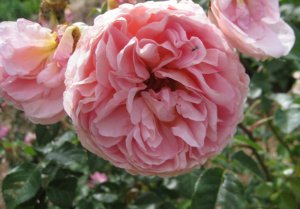 “I frequently tramped eight or ten miles through the deepest snow to keep an appointment with a beech-tree, or a yellow birch, or an old acquaintance among the pines.” ~Henry David Thoreau
“I frequently tramped eight or ten miles through the deepest snow to keep an appointment with a beech-tree, or a yellow birch, or an old acquaintance among the pines.” ~Henry David Thoreau
There are two main varieties of birch indigenous to North America, the well known white birch and the so called black birch with reddish-brown to black bark. Historically, the birch derives its name from a similar Sanskrit word translated as ‘that which is written upon.’ Numerous letters and journals have been inscribed on thin sheets of the multilayered bark of the white birch. The black birch can be differentiated from wild cherries because the broken twigs have the smell of wintergreen while those of the cherries exude a bitter almond odor. Wild cherry leaves and bark contain cyanide which, obviously, can be poisonous if too much is taken. How much is too much? Not sure about people but animals succumb quickly from eating the leaves of wild cherry. Livestock require diligence to prevent accidental poisoning.
The black birch grows largely in the cooler mountains where they have been important because of the nutritious inner layer of the bark. One example of the value of the bark is that it saved the lives of numerous confederate soldiers during Garnett’s Retreat across the Alleghenies before the men regrouped at Monterey, Virginia. I referred to this sustaining bark in Through the Fire and Red Bird’s Song, which can be gathered from the wild at any time of year.
 “It is not so much for its beauty that the forest makes a claim upon men’s hearts, as for that subtle something, that quality of air that emanation from old trees, that so wonderfully changes and renews a weary spirit.” ~Robert Louis Stevenson
“It is not so much for its beauty that the forest makes a claim upon men’s hearts, as for that subtle something, that quality of air that emanation from old trees, that so wonderfully changes and renews a weary spirit.” ~Robert Louis Stevenson
Also interesting to note, before the commercial oil of wintergreen was manufactured synthetically, it was distilled from the bark of the black birch. Indians and settlers made wintergreen tea by steeping freshly gathered leaves in boiling water as a remedy for rheumatism and headaches. The dried bark can also be used. One of its prime components is salicylic acid which is a main ingredient in aspirin, also found in willow. The bitterness in the leaves and thin bark of the willow also comes from salicylic acid which gives aspirin its own bitterness and makes the willow one of nature’s most important gifts to mankind. Native Americans used tea steeped from willow to treat fever, arthritis, and many other pains.
 A sweet syrup made from the white birch when the sap flows in the spring was used to treat cough and stomach cramps. The syrup could also help cure scurvy because it contains vitamin C. The bark and leaves of the white birch were used by some tribes as a topical application to cleanse ulcers and carbuncles, combat gangrene, and as a general disinfectant for skin diseases. The sap could be drunk as a syrup or applied directly to the skin depending on the ailment being treated.
A sweet syrup made from the white birch when the sap flows in the spring was used to treat cough and stomach cramps. The syrup could also help cure scurvy because it contains vitamin C. The bark and leaves of the white birch were used by some tribes as a topical application to cleanse ulcers and carbuncles, combat gangrene, and as a general disinfectant for skin diseases. The sap could be drunk as a syrup or applied directly to the skin depending on the ailment being treated.
Regarding the European white birch, Ms. Grieve says in A Modern Herbal: Coleridge speaks of it as the ‘Lady of the Woods.’ It is remarkable for its lightness, grace, and elegance, and after rain it has a fragrant odour.
The wood is soft and not very durable, but being cheap, and the tree being able to thrive in any situation and soil, growing all over Europe, is used for many humble purposes, such as bobbins for thread mills, herring-barrel staves, broom handles, and various fancy articles. In country districts the Birch has very many uses, the lighter twigs being employed for thatching and wattles. The twigs are also used in broom making and in the manufacture of cloth. The tree has also been one of the sources from which asphyxiating gases have been manufactured, and its charcoal is much used for gunpowder.
 The white epidermis of the bark is separable into thin layers, which may be employed as a substitute for oiled paper and applied to various economical uses. It yields oil of Birch Tar, and the peculiar, well-known odour of russia leather is due to the use of this oil in the process of dressing. It likewise imparts durability to leather, and it is owing to its presence that books bound in russia leather are not liable to become moldy. The production of Birch Tar oil is a Russian industry of considerable importance. It is also distilled in Holland and Germany, but these oils are appreciably different from the Russian oil. It has the property of keeping away insects and preventing gnat bites when smeared on the hands. It is likewise employed in photography.
The white epidermis of the bark is separable into thin layers, which may be employed as a substitute for oiled paper and applied to various economical uses. It yields oil of Birch Tar, and the peculiar, well-known odour of russia leather is due to the use of this oil in the process of dressing. It likewise imparts durability to leather, and it is owing to its presence that books bound in russia leather are not liable to become moldy. The production of Birch Tar oil is a Russian industry of considerable importance. It is also distilled in Holland and Germany, but these oils are appreciably different from the Russian oil. It has the property of keeping away insects and preventing gnat bites when smeared on the hands. It is likewise employed in photography.
 When the stem of the tree is wounded, a saccharine juice flows out which is susceptible, with yeast, of vinous fermentation. A beer, wine, spirit and vinegar are prepared from it in some parts of Europe. Birch Wine, concocted from this thin, sugary sap of the tree, collected from incisions made in the trees in March, honey, cloves and lemon peel being added and then the whole fermented with yeast, makes a very pleasant cordial, formerly much appreciated. From 16 to 18 gallons of sap may be drawn from one large tree, and a moderate tapping does no harm.~
When the stem of the tree is wounded, a saccharine juice flows out which is susceptible, with yeast, of vinous fermentation. A beer, wine, spirit and vinegar are prepared from it in some parts of Europe. Birch Wine, concocted from this thin, sugary sap of the tree, collected from incisions made in the trees in March, honey, cloves and lemon peel being added and then the whole fermented with yeast, makes a very pleasant cordial, formerly much appreciated. From 16 to 18 gallons of sap may be drawn from one large tree, and a moderate tapping does no harm.~































































